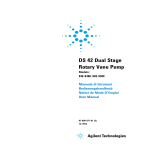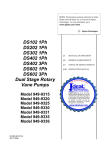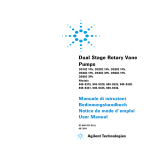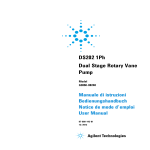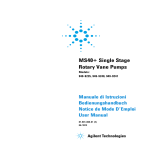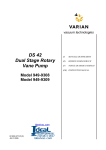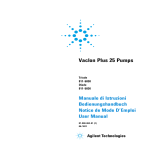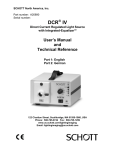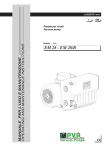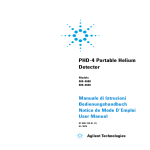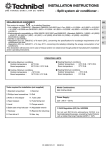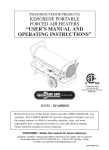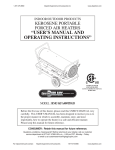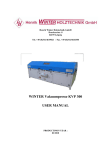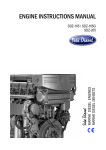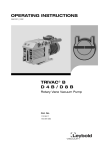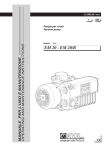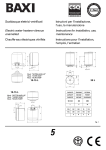Download HS452, HS652 Rotary Vane Pumps
Transcript
HS452, HS652 Rotary Vane Pumps Models 949-9360 949-9365 Manuale di Istruzioni Bedienungshandbuch Notice de Mode D’Emploi User Manual 87-900-978-01 (L) 11/2013 Warranty Notices © Agilent Technologies, Inc. 2012 No part of this manual may be reproduced in any form or by any means (including electronic storage and retrieval or translation into a foreign language) without prior agreement and written consent from Agilent Technologies, Inc. as governed by United States and international copyright laws. Manual Part Number Publication Number: 87-900-978-01 (L) Edition Edition 11/2013 Printed in ITALY Agilent Technologies Italia S.p.A. Vacuum Products Division Via F.lli Varian, 54 10040 Leinì (TO) ITALY The material contained in this document is provided “as is,” and is subject to being changed, without notice, in future editions. Further, to the maximum extent permitted by applicable law, Agilent disclaims all warranties, either express or implied, with regard to this manual and any information contained herein, including but not limited to the implied warranties of merchantability and fitness for a particular purpose. Agilent shall not be liable for errors or for incidental or consequential damages in connection with the furnishing, use, or performance of this document or of any information contained herein. Should Agilent and the user have a separate written agreement with warranty terms covering the material in this document that conflict with these terms, the warranty terms in the separate agreement shall control. Technology Licenses The hardware and/or software described in this document are furnished under a license and may be used or copied only in accordance with the terms of such license. Restricted Rights Legend If software is for use in the performance of a U.S. Government prime contract or subcontract, Software is delivered and licensed as “Commercial computer software” as defined in DFAR 252.227-7014 (June 1995), or as a “commercial item” as defined in FAR 2.101(a) or as “Restricted computer software” as defined in FAR 52.227-19 (June 1987) or any equivalent agency regulation or contract clause. Use, duplication or disclosure of Software is subject to Agilent Technologies’ standard commercial license terms, and nonDOD Departments and Agencies of the U.S. Government will receive no greater than Restricted Rights as defined in FAR 52.227-19(c)(1-2) (June 1987). U.S. Government users will receive no greater than Limited Rights as defined in FAR 52.227-14 (June 1987) or DFAR 252.227-7015 (b)(2) (November 1995), as applicable in any technical data. Trademarks Windows and MS Windows are U.S. registered trademarks of Microsoft Corporation. Safety Notices CAUTION A CAUTION notice denotes a hazard. It calls attention to an operating procedure, practice, or the like that, if not correctly performed or adhered to, could result in damage to the product or loss of important data. Do not proceed beyond a CAUTION notice until the indicated conditions are fully understood and met. WARNING A WARNING notice denotes a hazard. It calls attention to an operating procedure, practice, or the like that, if not correctly performed or adhered to, could result in personal injury or death. Do not proceed beyond a WARNING notice until the indicated conditions are fully understood and met. HS452, HS652 Rotary Vane Pumps User Manual / 87-900-978-01 (L) HS452 – HS652 Rotary Vane Pumps HS452 – HS652 Rotary Vane Pumps HS452, HS652 Rotary Vane Pumps User Manual / 87-900-978-01 (L) 3/126 HS452 – HS652 Rotary Vane Pumps 4/126 HS452, HS652 Rotary Vane Pumps User Manual / 87-900-978-01 (L) Contents Contents 1 Procedura per l’installazione Informazioni generali 9 10 Immagazzinamento 12 Preparazione per l’installazione 13 Installazione 15 Uso 19 Manutenzione 20 Smaltimento 2 22 Anleitung zur Installation Allgemeine Hinweise Lagerung 23 24 27 Vor der Installation 28 Installation 30 Gebrauch 34 Wartung 35 Entsorgung 37 3 Procédure pour l’installation Indications générales 39 40 Emmagasinage 42 HS452, HS652 Rotary Vane Pumps User Manual / 87-900-978-01 (L) 5/126 Contents Préparation pour l'Installation 43 Installation 45 Utilisation 49 Maintenance 50 Mise au Rebut 52 4 Installation Procedure 53 General Information 54 Storage 56 Preparation for Installation 57 Installation 59 Use 63 Maintenance Disposal 5 64 66 Technical Information Technical 67 Section I 69 Technical Description 67 69 Lubrication 71 Vacuum Seals 72 Gas Ballast Valve 73 Anti-Suckback Device 74 Technical Data 80 6/126 HS452, HS652 Rotary Vane Pumps User Manual / 87-900-978-01 (L) Contents Safety Precautions 83 Transport and Installation 84 Preliminary Operations 86 Section II 87 Connection to the Electric Supply 87 Connections to the Inlet and Exhaust Flanges 88 Starting and Running the Pump 90 Stopping the Pump 92 Safety Rules93 Maintenance Actions 96 Lubricants 98 Pump Electronic Controller 103 RS 232/RS 485 Communication Description 106 IP44 Accessory Kit P/N 949-9367115 Accessories 119 HS452, HS652 Rotary Vane Pumps User Manual / 87-900-978-01 (L) 7/126 Contents 8/126 HS452, HS652 Rotary Vane Pumps User Manual / 87-900-978-01 (L) HS452, HS652 Rotary Vane Pumps User Manual 1 Procedura per l’installazione Informazioni generali 10 Simboli usati 11 Immagazzinamento 12 Preparazione per l’installazione 13 Installazione Uso 15 19 Manutenzione 20 Smaltimento 22 Traduzione delle istruzioni originali 9/126 1 Procedura per l’installazione Informazioni generali Informazioni generali Questa apparecchiatura è destinata ad uso professionale. L'utilizzatore deve leggere attentamente il presente manuale di istruzioni ed ogni altra informazione addizionale fornita dalla Agilent prima dell'utilizzo dell'apparecchiatura. La Agilent si ritiene sollevata da eventuali responsabilità dovute all'inosservanza totale o parziale delle istruzioni, ad uso improprio da parte di personale non addestrato, ad interventi non autorizzati o ad uso contrario alle normative nazionali specifiche. Le pompe HS452 e HS652 sono delle pompe rotative bistadio a palette, a tenuta in bagno d'olio, azionate da motore elettrico trifase. Queste pompe da alto vuoto sono adatte al pompaggio di gas non corrosivi. Nei paragrafi seguenti sono riportate tutte le informazioni necessarie a garantire la sicurezza dell'operatore durante l'utilizzo dell'apparecchiatura. Informazioni dettagliate sono fornite nell'appendice “Technical information”. 10/126 HS452, HS652 Rotary Vane Pumps User Manual / 87-900-978-01 (L) Procedura per l’installazione Informazioni generali 1 Questo manuale utilizza le seguenti convenzioni: AVVERTENZA! I messaggi di avvertenza attirano l'attenzione dell'operatore su una procedura o una pratica specifica che, se non eseguita in modo corretto, potrebbe provocare gravi lesioni personali. ATTENZIONE! NOTA I messaggi di attenzione sono visualizzati prima di procedure che, se non osservate, potrebbero causare danni all'apparecchiatura. Le note contengono informazioni importanti estrapolate dal testo. Simboli usati I seguenti simboli sono utilizzati in modo coerente in tutte le illustrazioni: Flangia d’aspirazione Riempimento con liquido d’esercizio Flangia di scarico Pericolo “Vedere istruzioni di installazione/Modi d’uso” Zavorratore Superficie calda “Pericolo di scottature se vengono toccate le parti calde” HS452, HS652 Rotary Vane Pumps User Manual / 87-900-978-01 (L) 11/126 1 Procedura per l’installazione Immagazzinamento Immagazzinamento Durante il trasporto e l'immagazzinamento delle pompe non devono essere superate le seguenti condizioni ambientali: 12/126 temperatura: da -20 °C a +70 °C umidità relativa: 0 – 95 % (non condensante) HS452, HS652 Rotary Vane Pumps User Manual / 87-900-978-01 (L) Procedura per l’installazione Preparazione per l’installazione 1 Preparazione per l’installazione La pompa viene fornita in un imballo protettivo speciale; se si presentano segni di danni, che potrebbero essersi verificati durante il trasporto, contattare l'ufficio vendite locale. Il peso dell’imballo, comprensivo della pompa, è, al massimo, di circa 36 [Kg]. Durante l'operazione di disimballaggio, prestare particolare attenzione a non lasciar cadere la pompa e a non sottoporla ad urti o vibrazioni. Non disperdere l'imballo nell'ambiente. Il materiale è completamente riciclabile e risponde alla direttiva CEE 85/399 per la tutela dell'ambiente. NOTA La pompa non può essere danneggiata rimanendo semplicemente esposta all'atmosfera. Si consiglia comunque di mantenerla chiusa fino al momento dell'installazione sul sistema onde evitare eventuale inquinamento da polvere. NOTA La pompa è fornita con alcuni accessori standard: 1 bottiglia di olio Agilent GP 1 connettore "D" a 9 contatti per I/O (femmina) 1 connettore "D" a 9 contatti per RS232 (maschio) 1 fusibile T10A HS452, HS652 Rotary Vane Pumps User Manual / 87-900-978-01 (L) 13/126 1 Procedura per l’installazione Preparazione per l’installazione Specially Formulated for Dire Compound High Vacuum P Varian vacuum pump fluids are specifically e to provide superior performance in today's hi direct drive mechanical pumps. These precisely distilled fluids have been de lower base pressure capability, faster pumpand reduced maintenance requirements on b and the fluid. For specific information concer fluids contact the local Varian Industrial Prod ONE Liter Mod. 949-9390 ONE Liter P/N K7516301 EUROPE USA Mo P/ Figura 1 14/126 HS452, HS652 Rotary Vane Pumps User Manual / 87-900-978-01 (L) Procedura per l’installazione Installazione 1 Installazione Non installare e/o utilizzare la pompa in ambienti esposti ad agenti atmosferici (pioggia, gelo, neve), polveri, gas aggressivi, in ambienti esplosivi o con elevato rischio di incendio. Durante il funzionamento è necessario che siano rispettate le seguenti condizioni ambientali: temperatura: da +12 °C a +40 °C umidità relativa: 0 – 95 % (non condensante). AVVERTENZA! Per proteggere contro corto-circuiti o sovraccarichi, si deve installare un interruttore automatico sulla linea d’alimentazione principale verso i dispositivi Agilent, di capacità adeguata (vedere la tabella seguente): Tab. 1 P/N 110 Vac 949-9360 10 A 949-9365 220 Vac 6A ATTENZIONE! Prima di avviare la pompa, occorre procedere al rifornimento di olio lubrificante, poichè la pompa viene fornita scarica. HS452, HS652 Rotary Vane Pumps User Manual / 87-900-978-01 (L) 15/126 1 Procedura per l’installazione Installazione ATTENZIONE! Al fine di consentire una corretta circolazione d’aria assicurare uno spazio libero intorno alla pompa di almeno di 20 cm. AVVERTENZA! Togliere i tappi di protezione posti sulle flange di aspirazione e scarico prima di ogni successiva operazione. L’aria contenuta all’interno della pompa, in caso di accensione involontaria, può proiettarli contro l’operatore. AVVERTENZA! Durante l'installazione prestare la massima attenzione che la flangia di aspirazione sia collegata alla camera da evacuare e che la flangia di scarico non sia tappata (vedere la figura seguente). La pompa non deve essere usata come compressore. Figura 2 16/126 HS452, HS652 Rotary Vane Pumps User Manual / 87-900-978-01 (L) Procedura per l’installazione Installazione 1 AVVERTENZA! Allo scopo di garantire che la pressione interna al contenitore dell'olio non superi mai il valore massimo ammissibile di 1.7 bar (abs), sulla pompa è installato un dispositivo di sicurezza indicato dalla freccia rossa nella figura sottostante. Trattandosi di dispositivo di sicurezza, questo tappo non va in alcun modo sostituito, danneggiato o manomesso. E’ ammessa la sua momentanea rimozione (tramite svitamento) per consentire la carica dell’olio nella pompa quando necessario. E’ responsabilità dell’utente riavvitare il dispositivo nella sua posizione originaria dopo l’avvenuta carica dell’olio e prima dell’avvio della pompa. L'inosservanza di queste precauzioni può causare danni alla macchina ed all'operatore. Nel caso in cui la pressione del contenitore dell’olio superi i valori limite ammessi (ad esempio per scarico ostruito) una miscela di gas aspirati e olio fuoriuscirà dal tappo di sicurezza. Questa fuoriuscita continuerà fino allo spegnimento della pompa e/o alla rimozione della causa di sovrappressione (ad esempio rimozione dell’ostruzione dello scarico). Figura 3 HS452, HS652 Rotary Vane Pumps User Manual / 87-900-978-01 (L) 17/126 1 Procedura per l’installazione Installazione ATTENZIONE! Controllare che la tensione di alimentazione corrisponda a quella indicata sul cartellino del motore. Collegare la pompa all’alimentazione. AVVERTENZA! La pompa deve essere installata in modo tale da permettere una facile interruzione della linea d’alimentazione elettrica. Cavo d’alimentazione: Il giusto cavo per il collegamento elettrico è un cavo a tre fili (Fase+Neutro+Terra). La sezione del cavo deve essere di almeno 0,75 mm2 (AWG18). 18/126 HS452, HS652 Rotary Vane Pumps User Manual / 87-900-978-01 (L) Procedura per l’installazione Uso 1 Uso Prima di mettere la pompa in servizio effettivo è necessario, per il raggiungimento del vuoto limite, far marciare per circa un’ora la pompa con zavorra aperta allo scopo di eliminare l’umidità nell’olio. L'accensione della pompa non richiede particolari manovre; è sufficiente collegarla all’alimentazione elettrica agendo sull’interruttore bipolare. AVVERTENZA! La pompa è progettata per operare con fluidi neutri o non corrosivi. È assolutamente vietato l'impiego con sostanze potenzialmente esplosive o infiammabili. HS452, HS652 Rotary Vane Pumps User Manual / 87-900-978-01 (L) 19/126 1 Procedura per l’installazione Manutenzione Manutenzione Il personale addetto alla condotta ed alla manutenzione della pompa deve essere ben addestrato e deve avere un'approfondita conoscenza delle norme antinfortunistiche. AVVERTENZA! Le alte tensioni possono causare morte al contatto. Operare sempre con la massima cautela e secondo le norme antinfortunistiche in vigore. AVVERTENZA! Quando la macchina è alimentata prestare attenzione per la presenza di parti in movimento e di alta tensione. AVVERTENZA! Nel caso si debba procedere ad operazioni di manutenzione della pompa al termine di un periodo di esercizio, è necessario lasciarla raffreddare, poichè la temperatura esterna può superare i 60 °C. 20/126 HS452, HS652 Rotary Vane Pumps User Manual / 87-900-978-01 (L) Procedura per l’installazione Manutenzione 1 AVVERTENZA! Escludere sempre l'alimentazione della pompa prima di compiere operazioni di manutenzione. Apporre specifici cartelli di avvertenza: APPARECCHIATURA IN MANUTENZIONE - NON INSERIRE L'ALIMENTAZIONE, in corrispondenza dell'interruttore di alimentazione. Al termine ripristinare i dispositivi di sicurezza. AVVERTENZA! Non effettuare la sostituzione dell’olio subito dopo l’arresto della macchina, in quanto la temperatura dello stesso può essere elevata. NOTA Prima di rispedire al costruttore una pompa per riparazioni è indispensabile compilare e far pervenire al locale ufficio vendite la scheda "Sicurezza e Salute" allegata al presente manuale di istruzioni. Copia della stessa deve essere inserita nell'imballo della pompa prima della spedizione. Qualora una pompa dovesse essere rottamata, procedere alla sua eliminazione nel rispetto delle normative nazionali specifiche. HS452, HS652 Rotary Vane Pumps User Manual / 87-900-978-01 (L) 21/126 1 Procedura per l’installazione Smaltimento Smaltimento Significato del logo "WEEE" presente sulle etichette. Il simbolo qui sotto riportato è applicato in ottemperanza alla direttiva CE denominata "WEEE". Questo simbolo (valido solo per i paesi della Comunità Europea) indica che il prodotto sul quale è applicato, NON deve essere smaltito insieme ai comuni rifiuti domestici o industriali, ma deve essere avviato ad un sistema di raccolta differenziata. Si invita pertanto l'utente finale a contattare il fornitore del dispositivo, sia esso la casa madre o un rivenditore, per avviare il processo di raccolta e smaltimento, dopo opportuna verifica dei termini e condizioni contrattuali di vendita. 22/126 HS452, HS652 Rotary Vane Pumps User Manual / 87-900-978-01 (L) HS452, HS652 Rotary Vane Pumps User Manual 2 Anleitung zur Installation Allgemeine Hinweise 24 Verwendete Symbole Lagerung 26 27 Vor der Installation Installation 30 Gebrauch 34 Wartung 35 Entsorgung 37 28 Übersetzung der Originalanleitungen 23/126 2 Anleitung zur Installation Allgemeine Hinweise Allgemeine Hinweise Dieses Gerät ist für den professionellen Gebrauch bestimmt. Vor dem Gebrauch soll der Benutzer dieses Handbuch sowie alle weiteren von Agilent mitgelieferten Zusatzinformationen genau lesen. Bei vollständiger bzw. teilweiser Nichtbeachtung der enthaltenen Hinweise, unsachgemäßem Gebrauch durch ungeschultes Personal, nicht autorisierten Eingriffen und Benutzung unter Mißachtung der nationalen Bestimmungen übernimmt Firma Agilent keinerlei Haftung. Die Pumpen HS452 und HS652 sind dichte ölbadgeschmierte zweistufige Flügelzellenpumpen, die von einem Dreiphasenstrommotor betätigt werden. Diese Hochvakuumpumpen eignen sich für das Pumpen von nicht korrosiven Gasen. In den folgenden Abschnitten sind alle erforderlichen Informationen für die Sicherheit des Bedieners bei der Verwendung des Geräts aufgeführt. Detaillierte technische Informationen sind im Anhang "Technical Information" enthalten. 24/126 HS452, HS652 Rotary Vane Pumps User Manual / 87-900-978-01 (L) Anleitung zur Installation Allgemeine Hinweise 2 In dieser Gebrauchsanleitung werden Sicherheitshinweise folgendermaßen hervorgehoben: WARNUNG! Die Warnhinweise richten die Aufmerksamkeit des Bedieners auf eine spezielle Prozedur oder Praktik, die bei unkorrekter Ausführung schwere Personenschäden zur Folge haben könnte. VORSICHT! Die Vorsichtshinweise vor bestimmten Prozeduren machen den Bediener darauf aufmerksam, daß bei Nichteinhaltung Schäden am Gerät entstehen können. HINWEIS Die Hinweise enthalten wichtige Informationen, die aus dem Text hervorgehoben werden. HS452, HS652 Rotary Vane Pumps User Manual / 87-900-978-01 (L) 25/126 2 Anleitung zur Installation Allgemeine Hinweise Verwendete Symbole Folgende Symbole wurden durchgängig in allen Illustrationen verwendet: 26/126 Saugflansch Betriebsflüssigkeiten auffüllen Ablassflansch Gefahr – siehe Installations- und Gebrauchsanleitung Gasballastventil Heiße Oberfläche – Verbrennungsgefahr bei Berührung HS452, HS652 Rotary Vane Pumps User Manual / 87-900-978-01 (L) Anleitung zur Installation Lagerung 2 Lagerung Während des Transports und der Lagerung der Pumpen sollen die folgenden Umgebungsbedingungen gegeben sein: Temperatur: -20 °C bis +70 °C Relative Feuchtigkeit: 0 – 95 % (niederschlagsfrei) HS452, HS652 Rotary Vane Pumps User Manual / 87-900-978-01 (L) 27/126 2 Anleitung zur Installation Vor der Installation Vor der Installation Die Pumpe wird in einer speziellen Schutzverpackung geliefert. Eventuelle Transportschäden sind der zuständigen örtlichen Verkaufsstelle zu melden. Das Verpackungsgewicht beträgt, einschließlich der Pumpe, maximal 36 Kg. Beim Auspacken ist darauf zu achten, daß die Pumpe nicht fallengelassen oder Stößen oder Vibrationen ausgesetzt wird. Das Verpackungsmaterial ist ordnungsgemäß zu entsorgen. Es ist vollständig recyclebar und entspricht der EG-Richtlinie 85/399 für den Umweltschutz. HINWEIS Die Pumpe kann, wenn sie einfach der Atmosphäre ausgesetzt ist, nicht beschädigt werden. Sie sollte jedoch bis zur Installation an der Anlage geschlossen bleiben, um Verunreinigungen durch Staub zu vermeiden. HINWEIS Die Pumpe wird mit einigen Standardzubehörteilen geliefert: 28/126 1 Ölflasche Agilent GP 1 9-Stift-Stecker "D" für I/O (Steckbuchse) 1 9-Stift-Stecker "D" für RS232 (Stecker) 1 Sicherung T10A HS452, HS652 Rotary Vane Pumps User Manual / 87-900-978-01 (L) Anleitung zur Installation Vor der Installation 2 Specially Formulated for Dire Compound High Vacuum P Varian vacuum pump fluids are specifically e to provide superior performance in today's hi direct drive mechanical pumps. These precisely distilled fluids have been de lower base pressure capability, faster pumpand reduced maintenance requirements on b and the fluid. For specific information concer fluids contact the local Varian Industrial Prod ONE Liter Mod. 949-9390 ONE Liter P/N K7516301 EUROPE USA Mo P/ Abbildung 1 HS452, HS652 Rotary Vane Pumps User Manual / 87-900-978-01 (L) 29/126 2 Anleitung zur Installation Installation Installation Die Pumpe darf nicht in Umgebungen installiert und/oder benutzt werden, die ungeschützt vor Witterungsbedingungen (Regen, Frost, Schnee), Staub und aggressiven Gasen sind und in denen Explosionsoder erhöhte Brandgefahr besteht. Während des Betriebs sollen die folgenden Umgebungsbedingungen gegeben sein: WARNUNG! Temperatur: +12 °C bis +40 °C Relative Feuchtigkeit: 0 – 95 % (niederschlagsfrei). Zum Schutz vor Kurzschlüssen oder Überlastungen, muss ein automatischer Schalter in die Hauptspeisungsleitung zu den Agilent-Vorrichtungen installiert werden (siehe folgende Tabelle): Tab. 1 P/N 110 Vac 949-9360 10 A 949-9365 VORSICHT! 30/126 220 Vac 6A Die Pumpe ist vor ihrer Inbetriebnahme mit Schmieröl zu füllen, da sie leer geliefert wird. HS452, HS652 Rotary Vane Pumps User Manual / 87-900-978-01 (L) Anleitung zur Installation Installation VORSICHT! Um eine korrekte Luftzirkulation zuzulassen, sorgen Sie dafür, dass um die Pumpe herum ein freier Raum von mindestens 20 cm vorhanden ist. WARNUNG! Vor Aufnahme jeglicher Arbeiten sind die Schutzkappen an den Saug- und Druckflanschen zu entfernen. Die im Pumpeninnern enthaltene Luft könnte diese bei unbeabsichtigter Einschaltung gegen den Bediener schleudern. WARNUNG! Bei der Installation ist unbedingt darauf zu achten, dass der Saugflansch an die zu entleerende Kammer angeschlossen ist und der Ablassflansch nicht verschlossen ist (siehe nachstehende Abbildung). Die Pumpe darf nicht als Verdichter verwendet werden. 2 Abbildung 2 HS452, HS652 Rotary Vane Pumps User Manual / 87-900-978-01 (L) 31/126 2 Anleitung zur Installation Installation WARNUNG! Zur Gewährleistung, dass der Innendruck im Ölbehälter den zulässigen Höchstwert von 1.7 bar (abs) nicht übersteigt, ist in der Pumpe eine Sicherheitsvorrichtung installiert (siehe roter Pfeil im Bild). Es handelt sich um eine Sicherheitsvorrichtung, somit darf der Verschluss auf keinen Fall ersetzt, beschädigt oder manipuliert werden. Eine vorübergehende Entfernung (durch Abschrauben) ist möglich, damit das Öl bei Bedarf nachgefüllt werden kann. Der Anwender muss die Vorrichtung wieder in ihren Platz einschrauben, nachdem das Öl eingefüllt wurde und bevor die Pumpe wieder gestartet wird. Die Nichtbeachtung dieser Vorsichtsmaßnahmen kann der Maschine und dem Bediener Schaden zufügen. Falls der Druck in dem Ölbehälter die zugelassenen Werte überschreitet (zum Beispiel aufgrund eines verstopften Auslasses), wird eine Mischung aus angesaugtem Gas und Öl aus dem Sicherheitsverschluss treten. Dieses Austreten erfolgt bis zum Abschalten der Pumpe und/oder Beseitigung des Grunds für den Überdruck (zum Beispiel Entfernung der Verstopfung am Auslass). Abbildung 3 32/126 HS452, HS652 Rotary Vane Pumps User Manual / 87-900-978-01 (L) Anleitung zur Installation Installation VORSICHT! 2 Kontrollieren, daß die Versorgungsspannung mit der Spannungsangabe auf dem Typenschild des Motors übereinstimmt. Die Pumpe an das Versorgungsnetz anschließen. WARNUNG! Die Pumpe muss so installiert werden, dass die Stromversorgung leicht unterbrochen werden kann. Stromkabel: Für den Anschluss muss ein dreipoliges Kabel verwendet werden (Außenleiter + Neutral + Masse). Der Kabelquerschnitt muss mindestens 0,75 mm2 betragen (AWG18). HS452, HS652 Rotary Vane Pumps User Manual / 87-900-978-01 (L) 33/126 2 Anleitung zur Installation Gebrauch Gebrauch Vor der eigentlichen Inbetriebnahme der Pumpe ist es zur Erreichung des Grenzvakuums erforderlich, die Pumpe ungefähr eine Stunde mit geöffnetem Ballast laufen zu lassen, um die Feuchtigkeit aus dem Öl zu entfernen. Die Einschaltung der Pumpe erfordert keine speziellen Schritte, sie braucht nur durch Betätigung des zweipoligen (Version mit Einphasenstrommotor) oder des allpoligen Trennschalters (Version mit Dreiphasenstrommotor) an die elektrische Energieversorgungsquelle angeschlossen werden. WARNUNG! 34/126 Die Pumpe ist für den Betrieb mit neutralen und nicht korrosiven Fluiden konzipiert. Der Einsatz mit potentiell explosions- oder feuergefährlichen Substanzen ist streng verboten. HS452, HS652 Rotary Vane Pumps User Manual / 87-900-978-01 (L) Anleitung zur Installation Wartung 2 Wartung Das für den Betrieb und die Wartung zuständige Personal soll geschult sein und über eine solide Kenntnis der Unfallschutzvorschriften verfügen. WARNUNG! Hochspannungen können bei Kontakt tödliche Folgen haben. Es ist stets mit größter Vorsicht und gemäß der geltenden Unfallschutzvorschriften vorzugehen. WARNUNG! Bei eingeschaltetem Gerät ist auf Bewegungs- und Hochspannungsteile zu achten. WARNUNG! Falls die Pumpe im Anschluß an den Betrieb gewartet werden soll, ist abzuwarten, bis sie abgekühlt ist, da ihre Oberfläche eine Temperatur von 60 °C überschreiten kann. HS452, HS652 Rotary Vane Pumps User Manual / 87-900-978-01 (L) 35/126 2 Anleitung zur Installation Wartung WARNUNG! Vor Wartungsarbeiten ist die Pumpe stets energiefrei zu schalten. Am Netzschalter sind spezielle Warnschilder “INSTANDHALTUNG AM GERÄT – NICHT EINSCHALTEN” anzubringen. Nach Abschluß der Arbeiten sind die Sicherheitseinrichtungen wieder zu aktivieren. WARNUNG! Keine Ölwechsel unmittelbar nach Stillsetzung des Gerätes vornehmen, da die Öltemperatur sehr hoch sein kann. HINWEIS Bevor dem Hersteller eine Pumpe zur Reparatur zurückgesandt wird, ist das Formular “Sicherheit und Gesundheit” in der Anlage zum vorliegenden Handbuch auszufüllen und der lokalen Verkaufsstelle zuzustellen. Eine Kopie des Formulars ist der Pumpenverpackung vor dem Versand beizulegen. Bei eventueller Verschrottung einer Pumpe ist diese entsprechend der einschlägigen nationalen Vorschriften zu entsorgen. 36/126 HS452, HS652 Rotary Vane Pumps User Manual / 87-900-978-01 (L) Anleitung zur Installation Entsorgung 2 Entsorgung Bedeutung des "WEEE" Logos auf den Etiketten. Das folgende Symbol ist in Übereinstimmung mit der EU Richtlinie WEEE (Schrott von elektrischen und elektronischen Geräten) angebracht. Das nur in EU-Ländern gültige Symbol zeigt an, dass das betreffende Produkt NICHT zusammen mit normalem Haushalts- und Industriemüll entsorgt werden darf, sondern einem differenzierten Entsorgungssystem zugeführt werden muss. Der Endabnehmer sollte daher den Lieferanten des Geräts - die Muttergesellschaft oder den Wieder-verkäufer – kontaktieren, um die Abholung und Entsorgung nach Prüfen der Vertrags- und Verkaufsbedingungen einzuleiten. HS452, HS652 Rotary Vane Pumps User Manual / 87-900-978-01 (L) 37/126 2 Anleitung zur Installation Entsorgung 38/126 HS452, HS652 Rotary Vane Pumps User Manual / 87-900-978-01 (L) HS452, HS652 Rotary Vane Pumps User Manual 3 Procédure pour l’installation Indications générales 40 Symboles utilisés 41 Emmagasinage 42 Préparation pour l'Installation 43 Installation 45 Utilisation 49 Maintenance 50 Mise au Rebut 52 Traduction de la mode d’emploi originale 39/126 3 Procédure pour l’installation Indications générales Indications générales Cet appareillage a été conçu en vue d'une utilisation professionnelle. Il est conseillé à l'utilisateur de lire attentivement cette notice d'instructions ainsi que toute autre indication fournie par Agilent avant d'utiliser l'appareil. Agilent décline par conséquent toute responsabilité en cas de non-respect total ou partiel des instructions fournies, d'utilisation incorrecte de la part d'un personnel non formé, d'opérations non autorisées ou d'un emploi contraire aux réglementations nationales spécifiques. Les pompes HS452 e HS652 sont des pompes rotatives à deux stades à palettes, étanches en bain d'huile, actionnées par un moteur électrique triphasé. Ces pompes à vide poussé sont adaptées au pompage de gaz non corrosifs. Les paragraphes suivants fournissent toutes les indications nécessaires pour garantir la sécurité de l'opérateur pendant l'utilisation de l'appareillage. Des renseignements plus détaillés se trouvent dans l'appendice “Technical information”. 40/126 HS452, HS652 Rotary Vane Pumps User Manual / 87-900-978-01 (L) Procédure pour l’installation Indications générales 3 Cette notice utilise les signes conventionnels suivants: AVERTISSEMENT! Les messages d’avertissement attirent l'attention de l'opérateur sur une procédure ou une manœuvre spéciale dont la mauvaise exécution risque de provoquer de graves lésions. ATTENTION! NOTE Les messages d'attention apparaissent avant certaines procédures dont le nonrespect peut endommager sérieusement l'appareillage. Les notes contiennent des renseignements importants, extrapolés du texte. Symboles utilisés Les symboles suivants sont utilisés dans les différentes illustrations: Bride d’aspiration Remplissage fluide de fonctionnement Bride d’évacuation Danger “Voir instructions d’installation/Mode d’emploi” Soupape de lest Surface chaude “Risque de brûlure en cas de contact” HS452, HS652 Rotary Vane Pumps User Manual / 87-900-978-01 (L) 41/126 3 Procédure pour l’installation Emmagasinage Emmagasinage Pendant le transport et l'emmagasinage des pompes, il faut veiller à respecter les conditions environnementales suivantes: 42/126 température: de -20 °C à +70 °C humidité relative: 0 – 95 % (non condensant) HS452, HS652 Rotary Vane Pumps User Manual / 87-900-978-01 (L) Procédure pour l’installation Préparation pour l'Installation 3 Préparation pour l'Installation La pompe est fournie dans un emballage de protection spécial; si l'on constate des marques de dommages pouvant s'être produits pendant le transport, contacter aussitôt le bureau de vente local. Le poids total de l'emballage et de la pompe est au maximum de 36 Kg. Pendant l'opération d'ouverture de l'emballage, veiller tout particulièrement à ne pas laisser tomber la pompe et à ne lui faire subir aucun choc ni aucune vibration Ne pas jeter l'emballage dans la nature. Le matériel est entièrement recyclable et il est conforme à la directive CEE 85/399 en matière de protection de l'environnement. NOTE La pompe ne peut être endommagée en restant simplement exposée à l'atmosphère. Il est de toute façon conseillé de la garder dans son emballage jusqu'au moment de sa mise en fonction afin d'éviter toute pollution due à la poussière NOTE La pompe est équipée de certains accessoires standard: 1 bouteille d'huile Agilent GP 1 connecteur "D" à 9 broches pour E/S (femelle) 1 connecteur "D" à 9 broches pour RS232 (mâle) 1 fusible T10A HS452, HS652 Rotary Vane Pumps User Manual / 87-900-978-01 (L) 43/126 3 Procédure pour l’installation Préparation pour l'Installation Specially Formulated for Dire Compound High Vacuum P Varian vacuum pump fluids are specifically e to provide superior performance in today's hi direct drive mechanical pumps. These precisely distilled fluids have been de lower base pressure capability, faster pumpand reduced maintenance requirements on b and the fluid. For specific information concer fluids contact the local Varian Industrial Prod ONE Liter Mod. 949-9390 ONE Liter P/N K7516301 EUROPE USA Mo P/ Figure 1 44/126 HS452, HS652 Rotary Vane Pumps User Manual / 87-900-978-01 (L) Procédure pour l’installation Installation 3 Installation Ne pas installer et/ou utiliser la pompe dans des milieux exposés aux agents atmosphériques (pluie, gel, neige), à des poussières, à des gaz agressifs ainsi que dans des milieux explosifs ou à risque élevé d'incendie. Pendant le fonctionnement, il est nécessaire de respecter les conditions environnementales suivantes: Température: de +12 °C à +40 °C Humidité relative: 0 – 95 % (non condensant). AVERTISSEMENT! Pour protéger contre les court-circuits ou les surintensités, il faut installer un disjoncteur automatique sur la ligne d’alimentation principale vers les dispositifs Agilent, de bonne capacité (voir tableau ci-dessous): Tab. 1 P/N 110 Vac 949-9360 10 A 949-9365 ATTENTION! 220 Vac 6A Avant toute utilisation de la pompe, il est impératif de procéder à son remplissage en huile de lubrification car elle est livrée vide. HS452, HS652 Rotary Vane Pumps User Manual / 87-900-978-01 (L) 45/126 3 Procédure pour l’installation Installation ATTENTION! Pour permettre une bonne circulation de l’air, laissez un espace libre de 20 cm minimum autour de la machine. AVERTISSEMENT! Avant toute autre opération, retirer les bouchons de protection placés sur les brides d'aspiration et de vidange. En cas de mise en marche inopinée de l'appareillage, l'air contenu à l'intérieur de la pompe peut les projeter contre l'opérateur. AVERTISSEMENT! Pendant l'installation, faire très attention que la bride d'aspiration soit reliée à la chambre à vider et que la bride d'évacuation ne soit pas bouchée (voir la figure ci-après). La pompe ne doit pas être utilisée comme un compresseur. Figure 2 46/126 HS452, HS652 Rotary Vane Pumps User Manual / 87-900-978-01 (L) Procédure pour l’installation Installation 3 AVERTISSEMENT! Afin de garantir que la pression interne du réservoir d'huile ne dépasse jamais la valeur maximum admissible de 1,7 bars (abs), un dispositif de sécurité a été installé (indiqué par la flèche rouge ci-dessous). S'agissant d'un dispositif de sécurité, ce bouchon ne doit en aucun cas être remplacé, endommagé ou modifié. Il est possible de le retirer momentanément (en le dévissant) pour permettre le remplissage d'huile dans la pompe lorsque cela s'avère nécessaire. L'utilisateur est tenu de revisser le dispositif dans sa position initiale après avoir rempli le réservoir d'huile de la pompe et avant de la démarrer. Tout manquement à ces consignes comporte des risques pour la machine et l'opérateur. Au cas où la pression du réservoir d'huile dépasserait les valeurs limites admises (ex. suite à colmatage de l'évacuation) un mélange de gaz aspirés et d'huile sortira du bouchon de sécurité. Cette décharge de pression continuera jusqu'à l'arrêt de la pompe ou l'élimination de la cause de la surpression (élimination du colmatage de l'évacuation). Figure 3 HS452, HS652 Rotary Vane Pumps User Manual / 87-900-978-01 (L) 47/126 3 Procédure pour l’installation Installation ATTENTION! Contrôler que la tension d'alimentation correspond à la tension indiquée sur la plaquette du moteur. Brancher la pompe à la source d'alimentation. AVERTISSEMENT! La pompe doit être installée de manière à permettre une interruption facile du circuit d’alimentation électrique. Câble d’alimentation: le câble d’alimentation électrique doit être un câble à trois torons (Phase+Neutre+Terre). La section du câble doit être de 0,75 mm² minimum (AWG18). 48/126 HS452, HS652 Rotary Vane Pumps User Manual / 87-900-978-01 (L) Procédure pour l’installation Utilisation 3 Utilisation Avant la mise en service de la pompe, il est nécessaire, pour atteindre le vide maximum, de faire fonctionner la pompe pendant environ une heure avec le reniflard ouvert afin de supprimer l'humidité de l'huile. La mise en marche de la pompe ne requiert aucune manœuvre particulière ; il suffit de la brancher à l'alimentation électrique et d'agir sur l'interrupteur bipolaire (version avec moteur monophasé) ou unipolaire (version avec moteur triphasé). AVERTISSEMENT! La pompe a été conçue pour fonctionner avec des fluides neutres ou non corrosifs. L'emploi de substances potentiellement explosives ou inflammables est strictement interdit. HS452, HS652 Rotary Vane Pumps User Manual / 87-900-978-01 (L) 49/126 3 Procédure pour l’installation Maintenance Maintenance Le personnel chargé de la conduite et de la maintenance de la pompe doit avoir reçu la formation nécessaire et posséder une connaissance approfondie des normes de prévention des accidents du travail. AVERTISSEMENT! Les hautes tensions peuvent entraîner la mort par contact. Veiller à toujours opérer avec le maximum de prudence et dans le respect des normes de prévention des accidents du travail en vigueur. AVERTISSEMENT! Lorsque la machine est sous alimentation, faire attention à la présence d'organes en mouvement et de haute tension. AVERTISSEMENT! En cas de nécessité de procéder à des opérations de maintenance de la pompe au terme d'une période de fonctionnement, il est indispensable de la laisser refroidir car sa température extérieure peut être supérieure à 60 °C. 50/126 HS452, HS652 Rotary Vane Pumps User Manual / 87-900-978-01 (L) Procédure pour l’installation Maintenance 3 AVERTISSEMENT! Avant toute opération de maintenance, il est impératif de toujours couper l'alimentation de la pompe. Placer les pancartes spécifiques d'avertissement: APPAREILLAGE EN COURS DE MAINTENANCE – NE PAS BRANCHER L'ALIMENTATION, près de l'interrupteur d'alimentation. Au terme des opérations de maintenance, restaurer les dispositifs de sécurité. AVERTISSEMENT! Ne pas effectuer la substitution d'huile immédiatement après l'arrêt de la machine car la température de cette dernière peut être élevée. NOTE Avant de retourner une pompe au constructeur pour réparation, il est indispensable de remplir et d'adresser au bureau local de vente la fiche "Sécurité et Santé" jointe à la présente notice d'instructions. Une copie de celle-ci devra être mise dans l'emballage de la pompe avant expédition. En cas de mise au rebut de la pompe, procéder à son élimination conformément aux réglementations nationales en la matière. HS452, HS652 Rotary Vane Pumps User Manual / 87-900-978-01 (L) 51/126 3 Procédure pour l’installation Mise au Rebut Mise au Rebut Signification du logo "WEEE" imprimé sur les étiquettes. Le symbole indiqué ci-dessous a été appliqué conformément à la directive CE dénommée "WEEE". Ce symbole (valable uniquement pour les pays de la Communauté européenne) indique que le produit sur lequel il est appliqué NE DOIT PAS être mis au rebut avec les déchets domestiques ou industriels, mais doit être recyclé. Par conséquent, nous invitons l'utilisateur final à contacter le fournisseur du dispositif, qu'il s'agisse de la maison mère ou d'un revendeur, pour entreprendre le processus de mise au rebut, après vérification des termes et conditions du contrat de vente. 52/126 HS452, HS652 Rotary Vane Pumps User Manual / 87-900-978-01 (L) HS452, HS652 Rotary Vane Pumps User Manual 4 Installation Procedure General Information 54 Symbols used 55 Storage 56 Preparation for Installation 57 Installation Use 59 63 Maintenance 64 Disposal 66 Original Instructions 53/126 4 Installation Procedure General Information General Information This equipment is destined for use by professionals. The user should read this instruction manual and any other additional information supplied by Agilent before operating the equipment. Agilent will not be held responsible for any events occurring due to non-compliance, even partial, with these instructions, improper use by untrained persons, non-authorized interference with the equipment or any action contrary to that provided for by specific national standards. The HS452 and HS652 pumps are dual-stage, rotary vane pumps oil sealed, driven by a three-phases electric motor. These high vacuum pumps are suitable for pumping non corrosive gases. The following paragraphs contain all the information necessary to guarantee the safety of the operator when using the equipment. Detailed information is supplied in the appendix "Technical Information". 54/126 HS452, HS652 Rotary Vane Pumps User Manual / 87-900-978-01 (L) Installation Procedure General Information 4 This manual uses the following standard protocol: WARNING! The warning messages are for attracting the attention of the operator to a particular procedure or practice which, if not followed correctly, could lead to serious injury. CAUTION! The caution messages are displayed before procedures which, if not followed, could cause damage to the equipment. NOTE The notes contain important information taken from the text. Symbols used The following symbols are used consistently throughout in all illustration: Suction flange Filling up operating fluid Exhaust flange Warning “see installation/operating mode instruction” Gas Ballast valve Hot surface “Danger of burns if hot parts are touched” HS452, HS652 Rotary Vane Pumps User Manual / 87-900-978-01 (L) 55/126 4 Installation Procedure Storage Storage When transporting and storing the pumps, the following environmental requirements should not be exceeded: 56/126 temperature: from -20° to +70 °C relative humidity: 0 – 95 % (non-condensing) HS452, HS652 Rotary Vane Pumps User Manual / 87-900-978-01 (L) Installation Procedure Preparation for Installation 4 Preparation for Installation The pump is supplied in a special protective packing. If this shows signs of damage which may have occurred during transport, contact your local sales office. Total weight of the pack, including the pump, is approx. 36 Kg. When unpacking the pump, be sure not to drop it and avoid any kind of sudden impact or shock vibration to it. Do not dispose of the packing materials in an unauthorized manner. The material is 100 % recyclable and complies with EEC Directive 85/399. NOTE Normal exposure to the environment cannot damage the pump. Nevertheless, it is advisable to keep it closed until it is installed in the system, thus preventing any form of pollution by dust. NOTE The pump is provided with some standard accessories: 1 oil bottle Agilent GP 1 9 pin "D" connector for I/O (female) 1 9 pin "D" connector for RS232 (male) 1 fuse T10A HS452, HS652 Rotary Vane Pumps User Manual / 87-900-978-01 (L) 57/126 4 Installation Procedure Preparation for Installation Specially Formulated for Dire Compound High Vacuum P Varian vacuum pump fluids are specifically e to provide superior performance in today's hi direct drive mechanical pumps. These precisely distilled fluids have been de lower base pressure capability, faster pumpand reduced maintenance requirements on b and the fluid. For specific information concer fluids contact the local Varian Industrial Prod ONE Liter Mod. 949-9390 ONE Liter P/N K7516301 EUROPE USA Mo P/ Figure 1 58/126 HS452, HS652 Rotary Vane Pumps User Manual / 87-900-978-01 (L) Installation Procedure Installation 4 Installation Do not install or use the pump in an environment exposed to atmospheric agents (rain, snow, ice), dust, aggressive gases, or in explosive environments or those with a high fire risk. During operation, the following environmental conditions must be respected: WARNING! temperature: from +12 °C to +40 °C relative humidity: 0 – 95 % (non-condensing) Protect against short circuits and overload by installing on Agilent Device electrical main line an automatic circuit breaker of proper capacity (see table here below): Tab. 1 P/N 110 Vac 949-9360 10 A 949-9365 220 Vac 6A CAUTION! Before starting the pump, fill up with lubricating oil as the pump is delivered empty. CAUTION! Assure a free space all around the pump at minimum of 20cm to allow proper air circulation. HS452, HS652 Rotary Vane Pumps User Manual / 87-900-978-01 (L) 59/126 4 Installation Procedure Installation WARNING! Take out the protective caps on the suction and exhaust flanges before doing anything else. In the event of an accidental start-up, the air inside the pump could violently expel the protective caps and harm the operator. WARNING! During installation, pay maximum attention that the suction flange is connected to the vacuum chamber and the exhaust flange is not closed (see the following figure). The pump must not be used as a compressor. Figure 2 60/126 HS452, HS652 Rotary Vane Pumps User Manual / 87-900-978-01 (L) Installation Procedure Installation WARNING! 4 A safety device (indicated by the red arrow in the figure below) is installed on the pump to guarantee that the pressure inside the oil vessel never exceeds the maximum permitted value of 1.7 bar (abs). This is a safety device and for this reason the cap must not be replaced, damaged or tampered with. Temporary removal (by unscrewing) is allowed to fill oil into the pump when needed. Users are responsible for screwing the device back in its original position after filling and before starting the pump. Failure to respect these precautions may cause damage to the machine and injury to the operator. A mixture of intake gas and oil will issue from the safety cap if the pressure in the oil vessel exceeds the allowed limit values (e.g. obstructed exhaust). The flow will continue until the pump is stopped and/or the cause of overpressure is removed (e.g. obstruction is removed from exhaust). Figure 3 HS452, HS652 Rotary Vane Pumps User Manual / 87-900-978-01 (L) 61/126 4 Installation Procedure Installation CAUTION! Check that your electrical mains voltage corresponds to that indicated on the motor’s plate. Connect the pump to the power supply. WARNING! The pump must be installed in a way that allows an easy interruption of the line voltage. Power supply cord: The correct cable for electrical wiring is a three wires (Ph+N+Earth) cable. The wire section has to be at least 0.75 mm2 (AWG18). 62/126 HS452, HS652 Rotary Vane Pumps User Manual / 87-900-978-01 (L) Installation Procedure Use 4 Use Before being put into service, in order to reach maximum vacuum, the pump must be left running for about an hour with the gas ballast valve open. This will eliminate any humidity from the oil. There are no special procedures for switching the pump on; it needs only to be connected to the electric power by means of the bipolar switch. WARNING! The pump is designed for operation with neutral or non-corrosive fluids. It is absolutely forbidden to use potentially explosive or flammable substances. HS452, HS652 Rotary Vane Pumps User Manual / 87-900-978-01 (L) 63/126 4 Installation Procedure Maintenance Maintenance Personnel responsible for pump operation and maintenance must be well-trained and must be aware of the accident prevention rules. WARNING! Death may result from contact with high voltages. Always take extreme care and observe the accident prevention regulations in force. WARNING! When machine is powered take care on account of moving parts and high voltages. WARNING! If you have to perform maintenance on the pump after a considerable time in operation, leave it to cool as temperature of the outer surface may be in excess of 60 °C. WARNING! Always disconnect the power supply to the pump before starting maintenance work. Place a special warning signs over the power supply breaker switch: MACHINE UNDERGOING MAINTENANCE - DO NOT POWER ON. When finished, remove the safety warning. 64/126 HS452, HS652 Rotary Vane Pumps User Manual / 87-900-978-01 (L) Installation Procedure Maintenance WARNING! NOTE 4 Do not change the oil immediately after stopping the machine as the oil temperature may still be high. Before returning the pump to the constructor for repairs the "Health and Safety" sheet attached to this instruction manual must be filled-in and sent to the local sales office. A copy of the sheet must be inserted in the pump package before shipping. Pumps must be scrapped in accordance with the specific national standards. HS452, HS652 Rotary Vane Pumps User Manual / 87-900-978-01 (L) 65/126 4 Installation Procedure Disposal Disposal Meaning of the "WEEE" logo found in labels. The following symbol is applied in accordance with the EC WEEE (Waste Electrical and Electronic Equipment) Directive. This symbol (valid only in countries of the European Community) indicates that the product it applies to must NOT be disposed of together with ordinary domestic or industrial waste but must be sent to a differentiated waste collection system. The end user is therefore invited to contact the supplier of the device, whether the Parent Company or a retailer, to initiate the collection and disposal process after checking the contractual terms and conditions of sale. 66/126 HS452, HS652 Rotary Vane Pumps User Manual / 87-900-978-01 (L) HS452, HS652 Rotary Vane Pumps User Manual 5 Technical Information Section I 69 Technical Description Lubrication 71 Vacuum Seals 72 Gas Ballast Valve 69 73 Anti-Suckback Device 74 Technical Data 80 Dimensions Safety Precautions 82 83 Transport and Installation 84 Preliminary Operations Section II 86 87 Connection to the Electric Supply 87 Connections to the Inlet and Exhaust Flanges Starting and Running the Pump 88 90 Stopping the Pump 92 Safety Rules 93 Warning Notes 93 Caution Notes 95 Maintenance Actions 96 Lubricants 98 Original Instructions 67/126 5 Technical Information Disposal Pump Electronic Controller 103 Technical Specifications 103 Input/Output Communications: 104 RS 232/RS 485 Communication Description 106 J2 – Serial Port 106 Communication Format 107 Communication Protocol 107 Windows meaning 111 Electronic Self-Test 114 Rotor Lock Test 114 Oil Level Check 114 IP44 Accessory Kit P/N 949-9367 115 Protection against Solids115 Protection against Liquids 115 Protection against Liquids 115 IP44 Accessory Kit Use 116 Accessories 68/126 119 HS452, HS652 Rotary Vane Pumps User Manual / 87-900-978-01 (L) Technical Information Section I 5 Section I Technical Description The HS452 and HS652 pumps are rotary vane pumps oil sealed, driven by a three-phase electric motor. Figure 4 These vacuum pumps are suitable for pumping non corrosive gases. The main features are: all parts in direct contact with the fluid pumped are free of copper alloys; all materials are carefully selected to provide extended life; a high capacity gas ballast device allow to pump condensable vapors; all the parts composing the pump are fully replaceable due to the close machining tolerances and to the centering obtained by using reference pins; HS452, HS652 Rotary Vane Pumps User Manual / 87-900-978-01 (L) 69/126 5 Technical Information Technical Description due to its design features and low number of gaskets, the pump requires little maintenance, disassembly and reassemble are easy and require minimal time. The pump works with force-feed lubrication, provided by an auxiliary gear-pump driven by the rotor of the vacuum pump itself. This ensures proper lubrication even when pressures are close to atmospheric. The entire pump functional block is immersed in the oil contained in the casing. The oil guarantees perfect sealing of the discharge valves, enters the pump to ensure lubrication and sealing of the parts inside, facilitates heat dissipation and reduces pump noise. The pump is equipped with a special anti-suckback device which automatically isolates the vacuum system when the pump stops. This avoids rises in pressure or oil flow in the vacuum system while air is allowed back into the stator chambers. The air entering the pump after the anti-suckback device has closed prevents the oil in the casing from filling the stator chambers. The inner seals are achieved by the lubricating oil, thanks to the close machining tolerances. The vacuum pumps are connected directly to the electric motor through a flexible coupling, so that motion is transmitted even in case of poor alignment. A fan fitted on the joint and housed in the pump support produces a forced air flow over the finned surfaces of the casing to avoid oil overheating. 70/126 HS452, HS652 Rotary Vane Pumps User Manual / 87-900-978-01 (L) Technical Information Lubrication 5 Lubrication The pump’s lubricating system is force-feed type. Oil circulation is obtained by means of a gear pump connected to the rotor shaft. The oil is drawn through a gauze filter to prevent any foreign bodies from entering the pump. Shunt-mounted on the delivery line is a hydraulic piston which, besides actuating the anti-suckback device (see ANTI-SUCKBACK DEVICE), also regulates pressure by discharging excess oil flow directly into the tank. The required flow of oil under pressure passes through ducts that are drilled in the walls of the pump and lubricates the bushings and the inside parts. HS452, HS652 Rotary Vane Pumps User Manual / 87-900-978-01 (L) 71/126 5 Technical Information Vacuum Seals Vacuum Seals A special feature of this pump is the low number of gaskets that are employed. The seals in the circuit are obtained by means of VITON gaskets. The careful surface finish of the various parts of the pump means that vacuum sealing of the functional block is ensured by the film of oil separating metal surfaces. Sealing of the rotor shaft is guaranteed by a rotating gasket with dust-guard lip. The suction flange and duct are sealed by mean of OR gaskets. 72/126 HS452, HS652 Rotary Vane Pumps User Manual / 87-900-978-01 (L) Technical Information Gas Ballast Valve 5 Gas Ballast Valve When the pump sucks in vapors, these condense during compression and mix with the oil, forming an emulsion (an aqueous vapor, for example) or a solution (organic solvent vapors, for example). A number of problems arise from this, such as the impossibility of obtaining high vacuums, the alteration of the properties of the oil, could cause scaling on parts of the pump. To avoid this, during compression at the second stage, atmospheric air is let into the pump through an adjustable valve, or “gas ballast valve”, located at the top of the pump. In this way, the discharge valve of the second stage opens through the effect of the atmospheric air before the partial pressure of the vapor reaches saturation point, thus preventing condensation from occurring. The vapors are expelled mixed with air. HS452, HS652 Rotary Vane Pumps User Manual / 87-900-978-01 (L) 73/126 5 Technical Information Anti-Suckback Device Anti-Suckback Device The pump is equipped with a special anti-suckback device to avoid air pressure rises and/or oil back-flow towards the evacuated vessel when the pump is switched off. This device has a shutter which automatically closes the suction duct. In this way the pump and vacuum system are completely isolated from each other and air can enter the pump without any risk for the vacuum produced in the system. The device includes some special features, namely: drive obtained avoiding any form of contamination of the inlet duct by fluids (oil and/or air) used to command the shutter. Thanks to this, when the pump is started again, the pump-down to vacuum conditions is extremely fast as these contaminants are not present and no degassing is therefore required; suction flange maintained closed even when the pump is idle, so that pollutants cannot enter from the environment and no oil can overflow from the pump. Figure 5 74/126 Pump main asssemblies HS452, HS652 Rotary Vane Pumps User Manual / 87-900-978-01 (L) Technical Information Anti-Suckback Device Figure 6 5 View of the pump HS452, HS652 Rotary Vane Pumps User Manual / 87-900-978-01 (L) 75/126 5 Technical Information Anti-Suckback Device Legend (cf. figure View of the Pump) Tab. 2 76/126 N° Description 1 Inverter motor assy HS452-652 2 Rubber foot 3 Screw 4 Screw 5 Screw 7 Spacer 8 Motor support 9 Handle 10 Screw 11 Right sideplate 12 Board 14 Screw 15 Support plate 16 Cylindrical pin 17 Screw 18 Rubber crown 19 Half-joint with fan 20 Half-joint (pump side) 21 Oil-seal ring 22 Special screw 23 OR gasket 24 Gas Ballast Valve knob 25 Half-plate 26 Inlet screen SR03700237 27 OR gasket (1) - (2) 28 Suction flange 29 Anti-suckback shutter 30 Piston (1) - (2) (1) - (2) (1) - (2) (1) - (2) (1) - (2) HS452, HS652 Rotary Vane Pumps User Manual / 87-900-978-01 (L) Technical Information Anti-Suckback Device N° Description HS452-652 31 OR gasket (1) - (2) 32 Casing gasket (1) - (2) 33 Inner plate SR03700362 34 Pump support 35 Anti-wear bushing SR03700370 36 OR gasket (1) - (2) 37 Key motor side SR8999980301 38 First stage vane (1) 39 First stage rotor SR03700371 40 Spring (1) - (2) 41 Tongue SR8999980401 42 Second stage vane (1) 43 Second stage rotor SR03700367 44 Tie-rod SR03700335 45 OR gasket (1) - (2) 46 Bracket 47 Screw 49 Valve cover plate 50 Valve spring (1) - (2) 51 Valve gasket (1) - (2) 52 First stage stator SR03700419 53 Middle plate SR03700421 56 GasBallast Valve shutter (1) - (2) 57 GasBallast Valve spring (1) - (2) 58 Second stage stator SR03700364 59 Oil pump joint SR03700390 60 Special screw 61 End plate 62 Tongue 63 Washer HS452, HS652 Rotary Vane Pumps User Manual / 87-900-978-01 (L) 5 SR03700391 77/126 5 Technical Information Anti-Suckback Device 78/126 N° Description 64 Nut 69A External oil pump gear SR03700281 69B Internal oil pump gear SR03700277 70 Oil pump cover 71 Screw 73 Plate 74 Filter 75 Casing 76 Exhaust flange 77 OR gasket 78 Oil fill plug 79 Oil drain plug SR03700256 80 Oil drain plug gasket SR03700256 81 Left sideplate 83 Spring 84 Filter 86 Oil level indicator 99 Special screw 100 Piston 101 Arm 102 Spring (1) 103 OR gasket (1) - (2) 104 OR gasket (1) - (2) 105 Sleeve 106 Spring (1) 107 Ring (1) - (2) 108 Arm 109 Insert 110 Special washer 111 Screw HS452-652 (1) - (2) HS452, HS652 Rotary Vane Pumps User Manual / 87-900-978-01 (L) Technical Information Anti-Suckback Device NOTE 5 1. Part of Smart Pump Major Maintenance Kit (P/N 9499382) 2. Part of Smart Pump Minor Maintenance Kit (P/N 9499371) HS452, HS652 Rotary Vane Pumps User Manual / 87-900-978-01 (L) 79/126 5 Technical Information Technical Data Technical Data The following table lists the main technical data of the HS452 and HS652 pumps. Tab. 3 TECHNICAL DATA FREE AIR DISPLACEMENT Hz HS652 450 (27) 658 (39.5) l/min 46 l/min (m3/h) 327 (19.6) 478 (28.7) 66 m3/h 21 29.5 46 m3/h 14.5 20.5 ULTIMATE PARTIAL PRESSURE * mbar 10-4 10-4 ULTIMATE TOTAL PRESSURE * mbar 2⋅10-3 2⋅10-3 ULTIMATE TOTAL PRESSURE WITH GAS BALLAST * mbar 1⋅10-2 1⋅10-2 WATER VAPOR TOLERANCE mbar 30 30 WATER VAPOR CAPACITY g/h 550 550 OIL CAPACITY min/max l 0.6/1 0.6/1 MOTOR RATING 3ph kW 0.5 0.5 66 rpm 1980 1980 46 rpm 1350 1350 NOISE LEVEL with gas ballast closed dB(A) ≤ 60 ≤ 60 OIL TEMPERATURE °C 75 75 (pump operating) ** °F 169 169 NOMINAL ROTATION SPEED (low speed) 80/126 HS452 (m3/h) PUMPING SPEED (at 5 mbar inlet pressure) 66 UNITS Installation category II Pollution degree 2 HS452, HS652 Rotary Vane Pumps User Manual / 87-900-978-01 (L) Technical Information Technical Data TECHNICAL DATA Hz OPERATING TEMPERATURE RANGE WEIGHT UNITS HS452 HS652 °C 12 - 40 12 - 40 Kg 33 33 lb 72.7 72.7 INLET FLANGE DN 25KF 25KF EXHAUST FLANGE DN 25KF 25KF mm 515 515 5 Main Dimensions: - length - width mm 164 164 - height mm 271 271 Nominal Input Voltage V 100 – 120 200 - 240 100 – 120 200 - 240 Input frequency Hz 50 - 60 50 – 60 Max input power VA 1000 1000 Main Fuse (T type) A 10 10 m 2000 2000 Indoor Use Only Max Altitude * According to PNEUROP 6602 ** At ultimate total pressure, 20 °C (68 °F) room temperature HS452, HS652 Rotary Vane Pumps User Manual / 87-900-978-01 (L) 81/126 5 Technical Information Technical Data Dimensions The following figure shows the pump dimensions. WEIGHT Kg Figure 7 82/126 HS 452 and HS 652 pump dimensions HS452, HS652 Rotary Vane Pumps User Manual / 87-900-978-01 (L) Technical Information Safety Precautions 5 Safety Precautions WARNING! Always carry the pump by means of the handle provided. The pump must be set in position taking the upmost care in order to avoid accidental falls. In case of a need to handle the pump after a period of operation, it must be left to cool first as the external surface temperature may be in excess of 60 °C. HS452, HS652 Rotary Vane Pumps User Manual / 87-900-978-01 (L) 83/126 5 Technical Information Transport and Installation Transport and Installation The pumps are shipped to the customer inside cardboard boxes. Total weight of the pack, including the pump, is about 36 Kg. The case must be handled with care, using appropriate lifting equipment. CAUTION! When moving the case, ensure that it is securely bound to the lifting equipment and that the equipment is strong enough to support the weight. The pump’s working environment is a traditional industrial environment. Naturally sites with corrosive vapors or excessive heat are best avoided. Room temperature should ideally be between 12 °C and 40 °C. If the temperature is not inside this range, consult Agilent technical service for the changes required. Setting the pump in position should be performed as follows: 84/126 Pump laid on the ground. There are no special instructions for this type of installation, except that the floor should be as flat as possible and suited to bear the weight of the pump (it should ideally be a concrete floor) and of any accessories mounted on it. Note that the pump is stable on its base plate and it should not be necessary to anchor it to the floor with bolts and screws; also vibrations to and from the pump are greatly reduced by the use of rubber feet. Pump off the ground. In this case, the user must design a suitable support structure, remembering the following points: the plane supporting the pump must be perfectly horizontal; the structure should be adequately rigid; the relevant safety precautions should be applied. HS452, HS652 Rotary Vane Pumps User Manual / 87-900-978-01 (L) Technical Information Transport and Installation 5 Note also that the pump should be attached to the supporting structure after replacing the rubber feet with special antivibration feet, which should be screwed to the pump base and to the supporting plane. After taking the pump out of its packing case, you are advised to make the following checks: a Ensure that the pump has not suffered any damage during shipping. b Check that there are no uncovered or loose parts. HS452, HS652 Rotary Vane Pumps User Manual / 87-900-978-01 (L) 85/126 5 Technical Information Preliminary Operations Preliminary Operations Before starting the pump, fill up with lubricating oil as the pumps are delivered empty. NOTE A tin of oil is included in the packing. CAUTION! Oil must be poured into the casing through the special threaded plughole and NOT through the suction line. WARNING! Take out the protective caps on the suction and exhaust flanges before doing anything else. In the event of an accidental start-up, the air inside the pump could violently expel the protective caps and harm the operator. 86/126 HS452, HS652 Rotary Vane Pumps User Manual / 87-900-978-01 (L) Technical Information Section II 5 Section II Connection to the Electric Supply CAUTION! It is recommended to connect the pump to the power supply through a dedicated switch on the main electrical panel of the installation, or in proximity of the power supply connection point. HS452, HS652 Rotary Vane Pumps User Manual / 87-900-978-01 (L) 87/126 5 Technical Information Connections to the Inlet and Exhaust Flanges Connections to the Inlet and Exhaust Flanges Remove the protective caps from both flanges. Connect the system to be evacuated to the inlet flange, using a centering ring with OR and a locking collar. NOTE For guarantee reliable sealing, use an OR gasket in Perbunan or Viton. The inlet duct is equipped with a sieve filter preventing solid particles from entering and damaging the pump. NOTE When the gases to be pumped out contain dust, it is advisable to insert a dust filter before the inlet flange. NOTE When the gases to be pumped out contain large quantities of vapor, it is advisable to include a condense separator before the inlet flange. To make best use of the pump’s capacity, use only short, straight piping, with a diameter not smaller than that of the inlet flange. NOTE If rigid piping is used, it is good practice to use a flexible joint in order to avoid undue forcing of the connection on the pump. The exhaust duct must be connected to a pipe that will take away the pumped out gases. 88/126 HS452, HS652 Rotary Vane Pumps User Manual / 87-900-978-01 (L) Technical Information Connections to the Inlet and Exhaust Flanges 5 NOTE Application of an oil trap filter is necessary to avoid pollution of the surrounding atmosphere by the oil present in the exhaust duct during pump operation. CAUTION! Never block the pump exhaust line. This would cause overpressure in the casing with the risk of breaking the pumping block envelope. HS452, HS652 Rotary Vane Pumps User Manual / 87-900-978-01 (L) 89/126 5 Technical Information Starting and Running the Pump Starting and Running the Pump Before being put into service, in order to reach maximum vacuum, the pump must be left running for about an hour with the gas ballast valve open. This will eliminate any humidity from the oil. WARNING! NOTE The pump is designed for operation with neutral or non-corrosive fluids. It is absolutely forbidden to use potentially explosive or flammable substances. If the pump is started with cold oil, initially more than normal noise will be heard; this will last for a few minutes only until the oil reaches its working temperature. There are no special instructions for normal operation of the pump, which is delivered to you after completion of a running in cycle in the factory. If the pump is sucking in environments with liquids or vapors, it is important to leave it to run with the gas ballast open so as to avoid condensation of the vapors and contamination of the lubricating oil as a result. When there is no danger of the oil being contaminated, the gas ballast valve should be closed to reduce the pump’s power absorption. The gas ballast valve will prove useful in the cold season when, due to the lower room temperatures, it takes longer for the pump to reach rated temperature when switched on. Compression of the air forced in by the gas ballast valve develops heat, which in turn increases temperature of the oil faster. 90/126 HS452, HS652 Rotary Vane Pumps User Manual / 87-900-978-01 (L) Technical Information Starting and Running the Pump 5 NOTE If gases without vapors are sucked in, you are advised to open the gas ballast device from time to time in order to eliminate the traces of humidity they contain. NOTE For repetitive work cycles, with brief time intervals in between, it is better not to stop the pump. HS452, HS652 Rotary Vane Pumps User Manual / 87-900-978-01 (L) 91/126 5 Technical Information Stopping the Pump Stopping the Pump There are no special procedures for switching the pump off; it needs only to be disconnected from the electric power by means of the bipolar switch. When the pump is stopped, the anti-suckback device makes it possible to maintain vacuum in the vessel connected on the inlet flange of the pump. If the pump is expected to be stopped for a lengthy period, or in any case if it has pumped in large amounts of vapors, it is good practice to run it with the gas ballast open and the inlet line closed for a few minutes before switching off in order to limit the risk of corrosion or scaling due to pollution of the oil by condensed vapors. 92/126 HS452, HS652 Rotary Vane Pumps User Manual / 87-900-978-01 (L) Technical Information Safety Rules 5 Safety Rules Personnel responsible for pump operation and maintenance must be well-trained and must be aware of the accident prevention rules. The accident prevention precautions contained in this section must be respected at all times during operation and maintenance of the pump to avoid damage to operators and to the pump. These precautions are provided in the form of WARNING and CAUTION notes. WARNING! Operating procedures, technical information and precautions which, if not respected and/or implemented correctly may cause body harm to operators. CAUTION! Operating procedures, technical information and precautions which, if not respected and/or implemented correctly may cause damage to the pump. Warning Notes a Death may result from contact with high voltages. Always take extreme care and observe the accident prevention regulations in force. b Always disconnect the power supply to the pump before maintenance work. Place a special warning signs over the power supply breaker switch: MACHINE UNDERGOING MAINTENANCE - DO NOT POWER ON. c If you are performing maintenance after the pump has been operating for a considerable time, allow sufficient time for it to cool as the external surface temperature may be in excess of 60 °C. HS452, HS652 Rotary Vane Pumps User Manual / 87-900-978-01 (L) 93/126 5 Technical Information Safety Rules 94/126 d Failure to provide the pump with a ground connection may cause serious damage to operators. Always ensure that there is a ground connection and that it complies with the standards. e When cleaning the pump and its component parts, avoid the use of flammable or toxic solvents, such as benzin, benzol, ether or alcohol. The recommendation is to use a soap and water solution, preferably in ultrasound washing machines, taking care to dry all the cleaned parts at temperatures under 100 °C in order to eliminate residual moisture. f Prolonged overloads or breakdowns may cause the electric motor to overheat, and to release noxious smoke; remove the power immediately as a precaution and do not approach the pump at least until you have provided ventilation to drive out the smoke. Take care not to breathe in the fumes remaining inside the pump in the course of repair work. g In case of fire, do not throw water on the pump. Switch the power off and use CO2 extinguishers. h Carefully inspect the flanges to ensure that there are no dust, oil, dirt or defects of the mating surfaces, before making the required connections. i Ensure that all joints and couplings are locked correctly before starting the pump again after repair work. j Do not wear any objects that may become entangled in the mechanisms and/or act as conductors (chains, bracelets, etc.). k Ensure that the tools to be used are in perfect working condition and have insulating grips, where necessary. Check that the insulating material of the cables and that the conductors of the test equipment do not show any signs of damage. l Do not replace the oil immediately after stopping the machine as the oil may still be at high temperature. m Perform repairs in clean and, where possible, dust-free areas. Protect all the clearances of connection points with suitable plastic caps and cover the machined surface areas of all parts stripped down until they are put back on the pump again. HS452, HS652 Rotary Vane Pumps User Manual / 87-900-978-01 (L) Technical Information Safety Rules 5 Caution Notes a Before putting the pump back into operation after a breakdown, inspect it and check carefully for any other signs of damage. b Use only tools that are in perfect working order and specially designed for the job; use of inappropriate or ineffective tools may cause serious damage. c Perform repairs in clean and, where possible, dust-free areas. Protect all the clearances of connection points with suitable plastic caps and cover the machined surface areas of all parts stripped down until they are put back on the pump again. d Always check the lubricant and that it is properly distributed through the pump; inadequate lubrication may damage the pump seriously. e Give the parts some form of marking as you strip them down to ensure that you reassemble them again in the proper order. f Check that there are no scratches or grooves on the machined shafts, in their seats inside the pump or on machine-ground surfaces. Slight scratches and abrasions may be eliminated with very fine emery paper or by a little light grinding. g Before putting a group together, always spread a little oil over inner parts and mating surfaces. Replace all seals with original spare parts before reassembling components. HS452, HS652 Rotary Vane Pumps User Manual / 87-900-978-01 (L) 95/126 5 Technical Information Maintenance Actions Maintenance Actions Maintenance may be seen as the totality of all scheduled and unscheduled maintenance work. Maintenance includes: 1. SCHEDULED MAINTENANCE: Maintaining the nominal state of operation. 2. UNSCHEDULED MAINTENANCE: Restoring the nominal state of operation NOTE The frequency with which repairs are performed depends on the process and presence of substances that shorten pump life (dust, abrasives, solvents, water, chemically aggressive substances). The pump must be cleaned at regular intervals of time. CAUTION! Do not clean with Alcohol the plastic or rubber components of the pump. Use only the strictly necessary amount of lubricant; an excess of lubricating oil, like when there is none, may sometimes compromise proper operation of the pump. Only the recommended lubricants, or lubricating oils with similar characteristics and known and experimented quality, should be used. Oil changes must be made with the oil at a sufficiently high temperature, after leaving the pump to cool for a few minutes following operation. The drain and filler plugs must not be left open any longer than is strictly necessary. 96/126 HS452, HS652 Rotary Vane Pumps User Manual / 87-900-978-01 (L) Technical Information Maintenance Actions 5 When performing maintenance, look out for all signals that may precede a breakdown, in particular: traces of corrosion; oil leaks; slack joints or couplings. Maintenance technicians must: be aware of all applicable national directives concerning accident prevention during work on motor-driven pumps and should know how to apply them; have read and understood all the sections on “Safety Rules"; be familiar with the essential design features and operation of the pump; know how to use and consult the pump documentation; be concerned about proper operation of the pump; make a note of any irregularities in operation of the pump and take the necessary action, where appropriate. Use original spare parts wherever possible and repair a broken part as best as possible on site or send it back to the manufacturer for repairs. For all problems arising, or to order spare parts, refer to our service department. Agilent Technologies Italia S.p.A. Vacuum Products Division Via F.lli Varian, 54 10040 Leinì (TO) ITALY HS452, HS652 Rotary Vane Pumps User Manual / 87-900-978-01 (L) 97/126 5 Technical Information Lubricants Lubricants It will be readily understood how important adequate lubrication is to high technology pumps like the Agilent vacuum pumps. Correct use of appropriate lubricants makes a significant contribution to achieving best performance and warding off defects. When handling lubricants, the following sanitary protection measures should be observed at all times: Avoid prolonged, excessive or repeated contact of the skin with products for lubrication, and also avoid directly inhaling the fumes or vapors of such products. Protect the skin by wearing appropriate clothes and equipment (e.g. special suits, glasses or, where permitted by the safety regulations, gloves) or by applying a special protective product. Clean the skin carefully after contact with the lubricants by washing freely with water and soap. Apply a skin cream after washing. Take off and change clothes or shoes on which oil has been spilled. Never put rags dripping with oil into the pockets of your clothes. When disposing of waste lubricants, observe the following environment protection regulations: The lubricants risk contaminating the water and the ground! Therefore never pour lubricating products on to the ground, into water or in the sewage system. All violations of these rules are liable to persecution as provided for by law. When using lubricants always keep an oil can nearby. Take care in draining off waste oils. In disposal of these products respect all regulations in force concerning waste oil disposal. The recommended lubricating oil is the Agilent Rotary Vane Fluid DS19 Type. The Rotary Vane Fluid DS19 Type is a general purpose mechanical pump fluid specifically engineered to provide superior performance in high speed direct drive mechanical pumps. 98/126 HS452, HS652 Rotary Vane Pumps User Manual / 87-900-978-01 (L) Technical Information Lubricants 5 These precisely distilled fluids (100 % solvent refined neutral paraffinic oil) deliver lower base pressure capability, faster pumpdown cycles, and reduced maintenance requirements on both the pump and the fluid. It is absolutely necessary to continue using the lubricants initially used to fill the tank. If this is not possible for organizational or business reasons, use only products with the same characteristics as the previous oils. Only use of lubricants of suitable quality will guarantee safe operation of the pumps. CAUTION! Mineral oils and the PFPE oil are incompatible. To change from one type to another, the pump must be stripped down completely and all parts washed carefully to eliminate all oil residues. If you expect to have to use other lubricants, first find out if the two products are compatible. In cases of doubt, the lubricant used up to that time must be flushed out by way of a pump flushing procedure. CAUTION! To avoid the risk of contaminating the oil, absolute cleanliness of the pump and surrounding area must be ensured during the lubrication procedures. HS452, HS652 Rotary Vane Pumps User Manual / 87-900-978-01 (L) 99/126 5 Technical Information Lubricants Tab. 4 100/126 Agilent Rotary Vane Fluid DS19 Type characteristics PROPERTY UNIT OF MEASURE ROTARY VANE FLUID DS19 Type Vapor pressure @ 25 °C Torr 1·10-5 Boiling point @ 0,01 torr °C (°F) 112 (233) Viscosity @ 40 °C cSt (SUS) 55 (258) Viscosity @ 100 °C cSt (SUS) 8,1 (52,7) Pour point °C (°F) -15 (5) Flash point °C (°F) 213 (415) Fire point °C (°F) 244 (472) Density @ 25 °C g/ml 0,87 HS452, HS652 Rotary Vane Pumps User Manual / 87-900-978-01 (L) Technical Information Lubricants Figure 8 5 Agilent Rotary Vane Fluid DS19 Type vapor pressure curve HS452, HS652 Rotary Vane Pumps User Manual / 87-900-978-01 (L) 101/126 5 Technical Information Lubricants Figure 9 102/126 Agilent Rotary Vane Fluid DS19 Type viscosity curve HS452, HS652 Rotary Vane Pumps User Manual / 87-900-978-01 (L) Technical Information Pump Electronic Controller 5 Pump Electronic Controller Figure 10 Technical Specifications Input voltage: 100-120 V/50-60 Hz; 200 V-240 V/50-60 Hz Output voltage: 189 Vrms 3 ph; Max frequency: 68 Hz (factory setting) Starting phase maximum power: 780 W (maximum time: 15 min.) Normal Operation maximum power: 650 W Maximum room temperature: 40 °C Protection level: IP 44 (only using the accessory kit P/N 949-9367) CE mark: EN55011 cat “B” EN61000-3-2 EN61000-3-3 ESD EN61000-4-2 EN61000-4-3 HS452, HS652 Rotary Vane Pumps User Manual / 87-900-978-01 (L) 103/126 5 Technical Information Pump Electronic Controller EN6100-4-4 EN61000-4-5 RF EN61000-4-6 EN61000-4-8 EN61000-4-11 EN61010-1 CSA mark: EN61010-1, Installation category II, pollution degree 2 EN60950 Input/Output Communications: Tab. 5 104/126 P1 – I/O PIN N. SIGNAL NAME IN / OUT 1 Norm. Status (N.O. relay contact) out 2 Speed setting (0-10V) in 3 Oil level (relay contact) out 4 Start (-) in 5 Ground out 6 Norm. Status (N.O. relay contact) out 7 Oil level (relay contact) out 8 Start (+) in 9 24V out Remote Start/Stop Rotational speed setting by analog input (0-10 V): High speed (68 Hz): Vin>9 V Low speed (46 Hz): Vin<1 V frequency interlock (46Hz) HS452, HS652 Rotary Vane Pumps User Manual / 87-900-978-01 (L) Technical Information Pump Electronic Controller 5 Figure 11 NOTE The pump operation is I/O signals dependent so you must always plug in the provided mating connector to start the pump. HS452, HS652 Rotary Vane Pumps User Manual / 87-900-978-01 (L) 105/126 5 Technical Information RS 232/RS 485 Communication Description RS 232/RS 485 Communication Description Both the RS 232 and the RS 485 interfaces are available on the connector J2 J2 – Serial Port Tab. 6 PIN N. SIGNAL NAME 1 + 5 V out 2 TX (RS232) 3 RX (RS232) 4 Spare 5 GND 6 A+ (RS485) 7 Spare 8 B- (RS485) 9 Spare The communication protocol is the same (see the structure below), but only the RS 485 manages the address field. Therefore to enable the RS 485 is necessary to select the type of communication as well as the device address by means of the T-plus software. NOTE 106/126 The RS-485 is a 2-wires (gnd optional) half-duplex communication link. HS452, HS652 Rotary Vane Pumps User Manual / 87-900-978-01 (L) Technical Information RS 232/RS 485 Communication Description 5 Communication Format Physical level: both RS232 e RS485 8 data bit no parity 1 stop bit baud rate: 600/1200/2400/4800/9600 programmable Communication Protocol The communication protocol is a MASTER/SLAVE type where: Host = MASTER Pump = SLAVE The communication is performed in the following way: 1. the host (MASTER) send a MESSAGE + CRC to the controller (SLAVE); 2. the controller answer with an ANSWER + CRC to the host. The MESSAGE is a string with the following format: <STX>+<ADDR>+<WIN>+<COM>+<DATA>+<ETX>+<CRC> Where: NOTE When a data is indicated between two quotes (‘...’) it means that the indicated data is the corresponding ASCII character. <STX> (Start of transmission) = 0x02 <ADDR> (Unit address) = 0x80 (for RS 232) <ADDR> (Unit address) = 0x80 + device number (0 to 31) (for RS 485) HS452, HS652 Rotary Vane Pumps User Manual / 87-900-978-01 (L) 107/126 5 Technical Information RS 232/RS 485 Communication Description <WIN> (Window) = a string of 3 numeric character indicating the window number (from ‘000’ to ‘999’); for the meaning of each window see the relevant paragraph. <COM> (Command) = 0x30 to read the window, 0x31 to write into the window <DATA> = an alphanumeric ASCII string with the data to be written into the window. In case of a reading command this field is not present. The field length is variable according to the data type as per the following table:. Tab. 7 Data Type Field Length Valid Characters Logic (L) 1 ‘0’ = OFF ‘1’ = ON Numeric (N) 6 ‘-‘, ‘.’, ‘0’ . . . ‘9’ right justified with ‘0’ Alphanumeric (A) 10 from blank to ‘_’ (ASCII) <ETX> (End of transmission) = 0x03 <CRC> = XOR of all characters subsequent to <STX> and including the <ETX> terminator. The value is hexadecimal coded and indicated by two ASCII character. The addressed SLAVE will respond with an ANSWER whose structure depends from the MESSAGE type. When the MESSAGE is a reading command, the SLAVE will respond transmitting a string with the same structure of the MESSAGE. 108/126 HS452, HS652 Rotary Vane Pumps User Manual / 87-900-978-01 (L) Technical Information RS 232/RS 485 Communication Description 5 The controller can answers with the following response types: Tab. 8 Type Length Value Description Logic 1 byte - After a read instruction of a logic window Numeric 6 bytes - After a read instruction of a numeric window Alpha-numeric 10 bytes - After a read instruction of an alphanumeric window ACK 1 byte (0x6) The command execution has been successfully completed NACK 1 byte (0x15) The command execution has been failed Unknown Window 1 byte (0x32) The specified window in the command is not a valid window Data Type Error 1 byte (0x33) The data type specified in the command (Logic, Numeric or Alphanumeric) is not accorded with the specified Window Out of Range 1 byte (0x34) The value expressed during a write command is out of the range value of the specified window (0x35) The specified window is Read Only or temporarily disabled (some values cannot be changed while pump is running) Win Disabled NOTE 1 byte Using the RS 485 interface, the message structure remains identical to the one used for the RS 232 interface, the only difference being that the value assigned to the ADDRESS <ADDR> HS452, HS652 Rotary Vane Pumps User Manual / 87-900-978-01 (L) 109/126 5 Technical Information RS 232/RS 485 Communication Description Examples Command: START Source: PC Destination: Pump 02 80 30 30 STX ADDR WINDOW 30 31 31 03 42 WR ON ETX CRC 31 30 03 42 WR OFF ETX CRC 33 Source: Pump Destination: PC 02 80 06 03 38 STX ADDR ACK ETX CRC 35 Command: STOP Source: PC Destination: Pump 02 80 30 30 STX ADDR WINDOW 30 32 Source: Pump Destination: PC 110/126 02 80 06 03 38 STX ADDR ACK ETX CRC 35 HS452, HS652 Rotary Vane Pumps User Manual / 87-900-978-01 (L) Technical Information RS 232/RS 485 Communication Description 5 Command: READ PUMP STATUS Source: PC Destination: Pump (with address = 3) 02 83 32 30 STX ADDR WINDOW 35 30 03 38 37 RD ETX CRC Source: Pump (with address = 3 in stop status) Destination: PC 02 83 32 STX ADDR WINDOW 30 35 30 30 30 30 30 30 DATA (STATUS) 03 38 ETX CRC 37 Windows meaning Tab. 9 WIN TYPE DESCRIPTION 000 L START/STOP (1=START; 0=STOP) 001 L LOW SPEED [0=OFF / 1=ON] 008 L REMOTE/SERIAL CONFIGURATION (1=REMOTE; 0=SERIAL) 102 N SET POINT VALUE (Hz) 105 N SET POINT HYSTERESIS (%) [0-100] 108 N BAUD RATE (0-4) [600-1200-2400-4200-9600] 117 N LOW SPEED ADJUST (Hz) 120 N ROTATIONAL FREQUENCY SETTING [Hz] (High speed adjust) HS452, HS652 Rotary Vane Pumps User Manual / 87-900-978-01 (L) 111/126 5 Technical Information RS 232/RS 485 Communication Description WIN TYPE DESCRIPTION 200 N BUS CURRENT [mA] 201 N 3PHASE VOLTAGE [Vrms] 202 N POWER [W] 203 N DRIVING FREQUENCY 205 N [Hz]: (current driving frequency) STATUS [0=stop ; 2=ramp ; 3=autotuning ; 5=normal ; 6=fail] 206 N ERROR CODE Bit 7: motor block; Bit 6: short circuit; Bit 5: undervoltage; Bit 4: motor over temperature; Bit 3: power fail; Bit 2: controller overt; Bit 1: pump overt; Bit 0: spare 211 N CONTROLLER TEMPERATURE [°C] 216 N ENVIROMENT TEMPERATURE [°C] 300 N CYCLE TIME [min] 301 N CYCLE NUMBER 302 N PUMP LIFE [h] 319 A CONTROLLER MODEL 323 A CONTROLLER SERIAL NUMBER 325 A ELECTRICAL MODIFICATION LEVEL 500 L Monitor Mode (write only) 503 N RS485 SERIAL ADDRESS SETTING [0-31] 504 L SERIAL TYPE SELECT (0=RS323; 1=RS485) 112/126 HS452, HS652 Rotary Vane Pumps User Manual / 87-900-978-01 (L) Technical Information RS 232/RS 485 Communication Description 5 Operational limits: Tab. 10 Input Voltage (V) Controller status < 85 Power fail 85 – 140 Operative 140 – 170 Power fail 170 – 270 Operative > 270 Power fail Status Led Tab. 11 NOTE Led status Controller status Off Stop Green flashing Ramp – Autotuning Green Normal Operation Red Fail Slow red flashing (2 Hz) Oil level fail Quick red flashing (10 Hz) Oil level sensor fail Orange + Off Reset + selftest When you switch the controller on an electronic self-test is performed, during such phase you’ll see the led Orange for 1 sec. And turned off for two other seconds. Immediately after the first phase the controller perform a specific test on the pump rotor in order to be sure that it isn’t locked. HS452, HS652 Rotary Vane Pumps User Manual / 87-900-978-01 (L) 113/126 5 Technical Information RS 232/RS 485 Communication Description Electronic Self-Test When you switch the pump on with the main On/Off switch the pump doesn’t start immediately but it start only after about three seconds. This test time isn’t required if the pump is already powered as when it is operated in remote or serial mode. Rotor Lock Test After the electronic self-test the inverter perform a rotor lock test. This test requires about 5 seconds. During this time the rotor turns very slowly; after-wards the pump accelerate. The acceleration time is a function of the oil temperature and of the chamber volume to rough down. The lower is the oil temperature the longer is the time required to reach nominal speed. Oil Level Check An oil level check is performed four minutes after the pump starting. If the pump oil level is under the minimum threshold the pump controller generate a message you are able to receive by status led blinking (see the Status Led table), RS232 window (see Windows Meaning table) and a signal on I/O port (see I/O table). NOTE If the oil level check fails (low level) the pump doesn't stop. The test only activates the output described above. An Oil level sensor fail is highlighted by means of quick status led blinking and RS232 window (see "Status led" and "Window meaning" tables). 114/126 HS452, HS652 Rotary Vane Pumps User Manual / 87-900-978-01 (L) Technical Information IP44 Accessory Kit P/N 949-9367 5 IP44 Accessory Kit P/N 949-9367 Using the IP44 accessory kit you can make the pump protected against solid and liquids as defined here below: Protection against Solids Protection against accidental touch of parts under power or internal moving parts with tools, wires, or similar objects with a size larger than 1mm. Protected against intrusion of parts larger than 1mm. Protection against Liquids Water spray from all directions has no negative effect on the device. IP44 Accessory Kit Items 1 main plug bracket 2 bracket spacers 2 bracket screws/washers 1 socket rubber gasket 2 IP44 plastic shells for 9 pin “D” mating con-ector. HS452, HS652 Rotary Vane Pumps User Manual / 87-900-978-01 (L) 115/126 5 Technical Information IP44 Accessory Kit P/N 949-9367 IP44 Accessory Kit Use Figure 12 116/126 1 Remove the spring bracket mounted on standard IEC socket. 2 Insert the “D” rubber plate (item 1) into the pump’s IEC main socket pushing it till the socket bottom. 3 Screw down the two brackets spacers (items 2) on the standard IEC socket spacers 4 Insert the main cable plug. 5 Fix the main cable plug by using the bracket and screws/washers (item 3). 6 Exchange the 9 pin “D” mating connector plastic shells with the IP44 shells (items 4) contained in the IP44 accessory kit (see the following figure). HS452, HS652 Rotary Vane Pumps User Manual / 87-900-978-01 (L) Technical Information IP44 Accessory Kit P/N 949-9367 5 Figure 13 WARNING! To obtain the IP44 protection level you must set up the pump electrical connections as highlighted in the following figure. Figure 14 HS452, HS652 Rotary Vane Pumps User Manual / 87-900-978-01 (L) 117/126 5 Technical Information IP44 Accessory Kit P/N 949-9367 NOTE You must exchange the 9 pin “D” mating connector shells with the IP44 version even if you have no cable wired on the connector. In that case you have to use the plastic cap as showed in the following figure. Figure 15 118/126 HS452, HS652 Rotary Vane Pumps User Manual / 87-900-978-01 (L) Technical Information Accessories 5 Accessories Tab. 12 PART NUMBER DESCRIPTION 949-9390 Rotary Vane Fluid DS19 Type 1 L. bottle 949-9395 Smart Pump Oil mist eliminator 949-9392 Smart Pump Exhaust filter 949-9376 Smart Pump Oil return kit 949-9382 Smart Pump major maintenance kit 949-9371 Smart Pump minor maintenance kit 949-9367 Smart Pump IP44 accessory kit 949-9396 Power cable EU 949-9397 Power cable US 949-9398 Power cable UK 949-9399 Power cable IEC320 HS452, HS652 Rotary Vane Pumps User Manual / 87-900-978-01 (L) 119/126 5 Technical Information Accessories 120/126 HS452, HS652 Rotary Vane Pumps User Manual / 87-900-978-01 (L) Request for Return Form United States Agilent Technologies Vacuum Products Division 121 Hartwell Avenue Lexington, MA 02421 - USA Tel.: +1 781 861 7200 Fax: +1 781 860 5437 Toll-Free: +1 800 882 7426 Sales and Service Offices India Agilent Technologies India Pvt. Ltd. Vacuum Product Division G01. Prime corporate Park, 230/231, Sahar Road, Opp. Blue Dart Centre, Andheri (East), Mumbai – 400 099.India Tel: +91 22 30648287/8200 Fax: +91 22 30648250 Toll Free: 1800 113037 Italy Agilent Technologies Italia S.p.A. Vacuum Products Division Via F.lli Varian 54 10040 Leini, (Torino) - Italy Tel.: +39 011 997 9111 Fax: +39 011 997 9350 Toll-Free: 00 800 234 234 00 Southeast Asia Agilent Technologies Sales Sdn Bhd Vacuum Products Division Unit 201, Level 2 uptown 2, 2 Jalan SS21/37, Damansara Uptown 47400 Petaling Jaya, Selangor, Malaysia Tel: +603 7712 6106 Fax: +603 6733 8121 Taiwan Agilent Technologies Taiwan Limited Vacuum Products Division (3F) 20 Kao-Shuang Rd., Pin-Chen City, 32450 Taoyuan Hsien , Taiwan, R.O.C. Tel. +886 34959281 Toll Free: 0800 051 342 Canada Central coordination through: Agilent Technologies Vacuum Products Division 121 Hartwell Avenue Lexington, MA 02421 - USA Tel.: +1 781 861 7200 Fax: +1 781 860 5437 Toll-Free: +1 800 882 7426 Japan Agilent Technologies Japan, Ltd. Vacuum Products Division 8th Floor Sumitomo Shibaura Building 4-16-36 Shibaura Minato-ku Tokyo 108-0023 - Japan Tel.: +81 3 5232 1253 Fax: +81 3 5232 1710 Toll-Free: 0120 655 040 UK and Ireland Agilent Technologies UK, Ltd. Vacuum Products Division 6 Mead Road Oxford Industrial Park Yarnton, Oxford OX5 1QU – UK Tel.: +44 (0) 1865 291570 Fax: +44 (0) 1865 291571 Toll free: 00 800 234 234 00 China Agilent Technologies (China) Co. Ltd Vacuum Products Division No.3, Wang Jing Bei Lu, Chao Yang District Beijing, 100102, China Tel: +86 (0)10 64397888 Fax: +86 (0)10 64391318 Toll free: 800 820 3278 Korea Agilent Technologies Korea, Ltd. Vacuum Products Division Shinsa 2nd Bldg. 2F 966-5 Daechi-dong Kangnam-gu, Seoul Korea 135-280 Tel: +82 (0)2 3452 2455 Fax: +82 (0)2 3452 3947 Toll free: 080 222 2452 Other Countries Agilent Technologies Italia S.p.A. Vacuum Products Division Via F.lli Varian 54 10040 Leini, (Torino) Italy Tel.: +39 011 997 9111 Fax: +39 011 997 9350 Toll-Free: 00 800 234 234 00 France Agilent Technologies France Vacuum Products Division 7 Avenue des Tropiques Z.A. de Courtaboeuf - B.P. 12 91941 Les Ulis cedex - France Tel.: +33 (0) 1 69 86 38 84 Fax: +33 (0) 1 69 86 29 88 Toll free: 00 800 234 234 00 Mexico Agilent Technologies Vacuum Products Division Concepcion Beistegui No 109 Col Del Valle C.P. 03100 – Mexico, D.F. Tel.: +52 5 523 9465 Fax: +52 5 523 9472 Customer Support & Service Germany and Austria Agilent Technologies Sales & Services GmbH & Co. KG Vacuum Products Division Lyoner Str. 20 60 528 Frankfurt am Main GERMANY Tel: +49 69 6773 43 2230 Fax: +49 69 6773 43 2250 Singapore Agilent Technologies Singapore Pte. Ltd, Vacuum Products Division Agilent Technologies Building, 1 Yishun Avenue 7, Singapore 768923 Tel: (65) 6215 8045 Fax: (65) 6754 0574 Benelux Agilent Technologies Netherlands B.V. Vacuum Products Division Herculesweg 8 4338 PL Middelburg The Netherlands Tel.: +31 118 671570 Fax: +31 118 671569 Toll-Free: 00 800 234 234 00 © Agilent Technologies, Inc. 2013 Printed in ITALY 11/2013 Publication Number: 87-900-978-01 (L) NORTH AMERICA: Toll Free: 800 882 7426, Option 3 [email protected] EUROPE: Toll Free: 00 800 234 234 00 [email protected] PACIFIC RIM: please visit our website for individual office information http://www.agilent.com Worldwide Web Site, Catalog and Order On-line: www.agilent.com Representative in most countries 1/12






























































































































